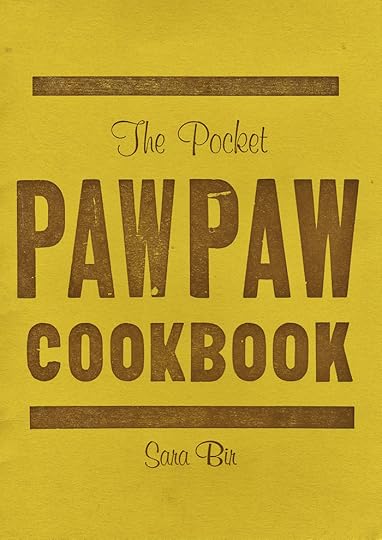Why I Won’t Self-Publish a Cookbook Again
 A guest post by Sara Bir
A guest post by Sara Bir
I’ve written three cookbooks. The second two I did with traditional publishers, but the first one I self-published. Would I self-publish a cookbook again? That was the question I faced last year when I decided to do an expanded version of The Pocket Pawpaw Cookbook, my first book.
Pawpaws are a little-known fruit that grow in less than a third of the country and aren’t sold at grocery stores. They are in season for two months a year, max. I live in Ohio, where they grow abundantly, and I’m totally besotted with them.
So of course I thought this under-the-radar food deserved its own cookbook. But a pawpaw cookbook doesn’t exactly spark a bidding war among conventional publishers.
Still, I decided a slender cookbook devoted to pawpaws was a great idea for offbeat cookbook readers and lovers of unusual fruit. I set a deadline for myself, wrote the book, and self-published 473 copies as an experiment. (Why 473 copies? I hand-printed covers on my friend’s antique printing press. Of the 500 sheets of card stock I started with, I screwed up 27 of them.) At all of 38 pages, it was more of a deluxe zine than a full-blown cookbook. But a tiny niche of people really responded to it.
When I sold the last copy a few years ago, I knew I wanted to make an updated edition, and after thinking it over, tried my luck with a publisher. I’m glad I did.
Here’s why won’t self-publish a cookbook again:1. Creating inspires me and leg work tires me.
I like collaborations, creating things, and working with a team I’m not 100% in charge of.
But when you self-publish a cookbook, it comes with tracking sales, fulfilling orders, and getting other people to sell my book. For me, that’s tiresome. When you self-publish a cookbook, everything is up to you, including hiring people to do the parts you can’t, or don’t want, to do. I outsourced illustrations, cover design, interior layout, and the actual printing and binding of the pages. All the other stuff I did myself.
Project managing a 38-page zine was doable, but a full-blown cookbook? That’s not a good fit for a person whose passion is for pawpaws, not publishing.

I worked with my printmaker friend to select typeface and hand-print covers for the first Pocket Pawpaw Cookbook. Pawpaws have flesh with a similar yellow hue, and pawpaw color of the cover drew people in.
2. I’m happy with small publishers .
For the second edition of The Pocket Pawpaw Cookbook, I worked with Belt Publishing, a regional indie publisher. They work on a small scale to address topics pertinent to the Midwest and Rust Belt (which is exactly where I live, and where pawpaws thrive).
So they’re a great fit for my project. I knew about them from their anthologies, but they got on my radar as a possible publisher when I heard about The Belt Cookie Table Cookbook. Its regional focus and folksy manner mirrored what I envisioned for the new edition of The Pocket Pawpaw Cookbook, and they were receptive to my idea. I love the rapport I have with my editor, and I don’t have to stress about being a lone wolf the way I would if I were self-publishing.
3. I’m okay not having total control.
I’m opinionated and like having a lot of say, especially for a passion project like this pawpaw book. Self-publishing gave me total control, but then I had to do everything else, too, or hire someone else, to:
Create an indexDo a copy edit and proofreadDesignPromote.Of those things, promotion is the only one I like. For my latest traditionally-published cookbook, I had to swap total control for less responsibility. I’m fine with that. But if I were a new author with a funky idea and specific vision, I might not feel that way.
4. My financial investment is low.
My other two cookbooks with publishers were fine experiences. The Fruit Forger’s Companion won an IACP cookbook award. Neither has sold well, though. If you’ve ever heard that publishers want authors who have sold at least 5 to 10 thousand self-published books before giving them a book contract, that’s wrong. I am living proof this is not the case.
With tireless self-promotion, I could have sold a few thousand pawpaw books on my own, but eventually I’d run out of pawpaw lovers (not to mention my own energy). I knew a second edition of my book could do better with actual distribution and publicity, but the scale needed to remain small.

The design team at Belt Publishing referred to the original cover to an extent. They used a green color scheme to evoke the canopy of the woods where pawpaws grow.
5. I’m off the hook for distribution.
Distribution is how you get books to retailers and readers. When I self-published a cookbook, I quickly tired of trips to the post office to fill orders, which came in sporadically. I sold copies online, at a couple of festivals, and when I taught cooking classes. I also bartered quite a few, some as payment for design work and some to get beer at festivals.
If I decided to self-publish the second edition, I could have found a publisher to do the distribution for me. Someone else could tap into the wide reach they’ve spent years building. Chelsea Green Publishing said they’d be happy to do it (they published my “real” cookbook, The Fruit Forager’s Companion). I spoke with a few other self-published authors who’d had used Chelsea Green for their distribution, but in the end I went with the full traditional publishing experience.
Now I can focus on promoting (which I like), but not actually hustling the physical copies (which I don’t). No more awkward wrangling with a Square reader at the book signing table! I’m thrilled to simply proselytize the many pleasures of pawpaws instead.
I mostly enjoyed my one small foray into self-publishing. It was an experiment with a positive outcome, but one I’m thankful not to repeat. And if I want a copy of the first edition for old time’s sake? I’d have to find an early customer and barter. I truly did sell every last copy, which is not a bad way to end a self-publishing venture.
* * *
Sara Bir is a chef and writer. Her books include The Pocket Pawpaw Cookbook , Tasting Ohio , and The Fruit Forager’s Companion . An editor with the website Simply Recipes, her other pursuits include plantspotting and roller derby.
* * *
Also by Sara Bir:What Makes an Award-Winning Cookbook? What I Learned Writing a Cookbook as a Late Bloomer(Disclosure: This post contains affiliate links.)
The post Why I Won’t Self-Publish a Cookbook Again appeared first on Dianne Jacob, Will Write For Food.
 newest »
newest »
 Wow! Thank you for this. All things I never thought through. - Mikel
Wow! Thank you for this. All things I never thought through. - Mikel



